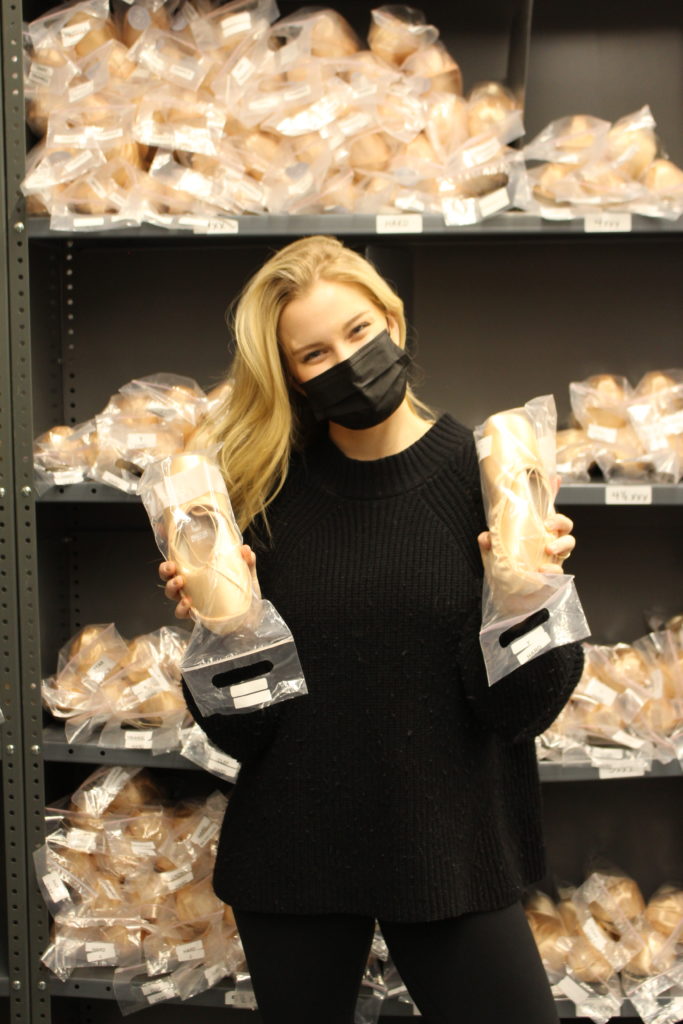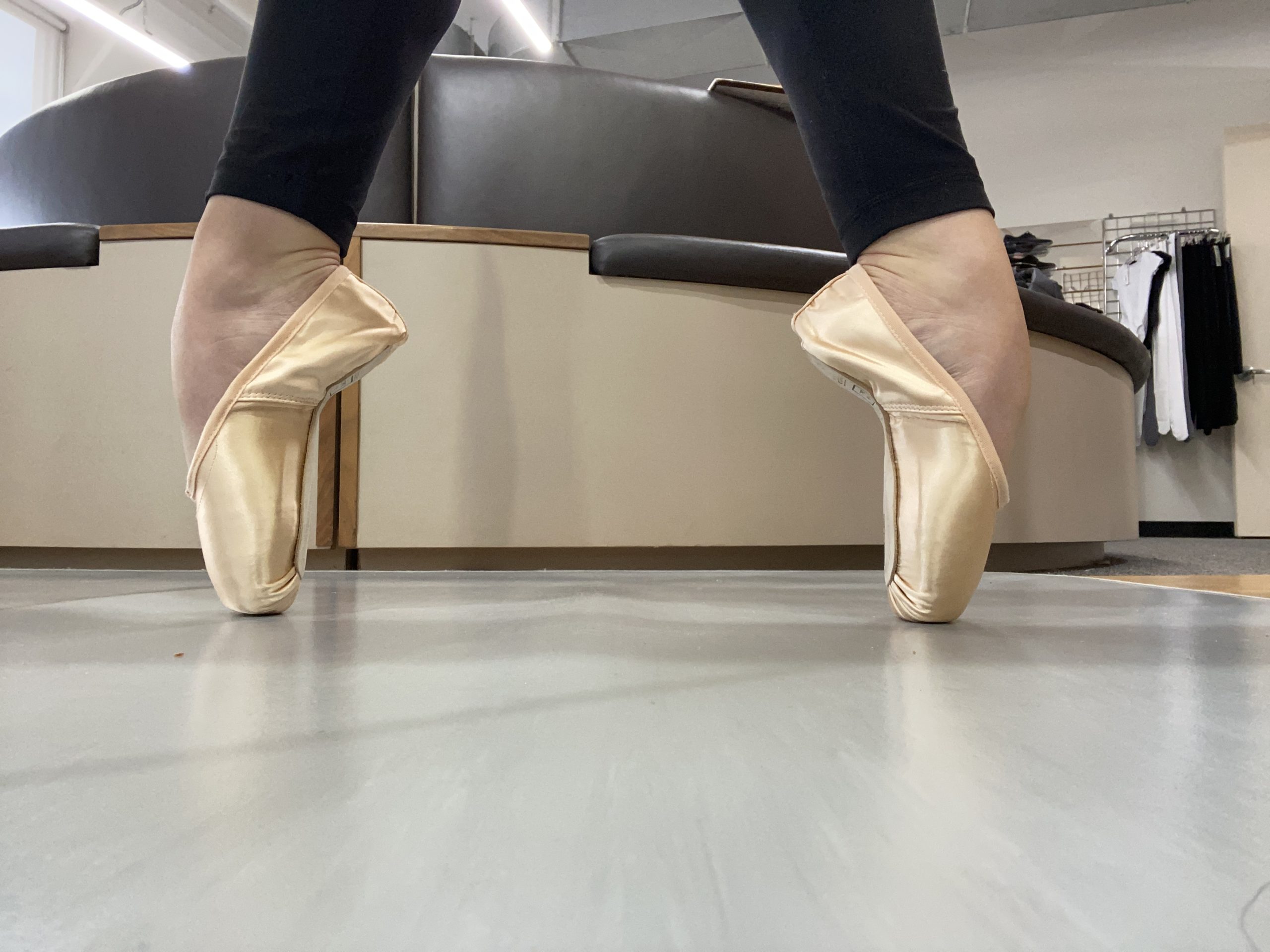Begin Again: Finding My Perfect Pointe Shoe
Raise your hand if you knew that the shape of your feet can change over time. If you did, you’re smarter than me and I respect that. If you didn’t, welcome to the club!
After nine years off of dancing, the last thing I anticipated to be a problem in my training was my feet. (Other than an unfortunate metatarsal break in high school, we’ve always gotten along.) But as I’ve slipped into my Grishko 2007s and felt the throbbing ache that pulses through my toes with even just a few relevés, I’ve realized it’s time to leave my old shoes in the past and embrace the future with my new feet.
So I went on a quest—to find my perfect shoe. To start, I scheduled fitting appointments in New York City with experts from Bloch, Capezio, Freed of London and Gaynor Minden. As far as I can remember, I haven’t done an actual fitting since I was 12 years old and got my first pair of pointe shoes. And I realized this: Getting fitted by someone capable can make all the difference. If you are feeling like something is off with your shoes, take the time and reach out to your manufacturer (or a new one if you want to try something different), and see what can be adjusted. I learned so much about my feet and can’t wait to see how my dancing improves with the right set of shoes complementing them.
Gaynor Minden
I started my search at Gaynor Minden’s boutique on 16th Street in Manhattan. The in-person store is closed to the public right now, but they let me come in to capture the experience of a fitting for Dance Magazine readers. If you’re interested in trying out Gaynor Minden, two of the company’s shoe fitters, Anna Pearson and Robyn Jutsum, recommend trying the virtual fitting service on its website.

What the fitters taught me:
- I have what is known as a “disappearing heel.” This means that when I point my feet, my heel bones slide in toward my ankles, causing the backs of a lot of shoes to gape or slip off.
- Minor differences in models can make a major difference in my dancing. For example, I was brought two similar shoes to try, but one of them had a slightly wider box. When I went to relevé, the one with the wider box had me sitting back in my shoe while the more narrow box had me firmly on top of the box.
Gaynor Minden shoe of choice: Classic Fit, CL-7M4SDH
Pros:
- This shoe is uber comfortable. I don’t feel any pain or pinching anywhere on my foot.
- Gaynors are made of unbreakable elastomeric materials (the same as what’s found in athletic footwear and equipment), which should, in theory, make them last longer than other pointe shoes.
- It’s really pretty! It shows off my assets without making me feel like I’m going to pop out of the shoe.
Cons:
- At over $150, Gaynors are pricey. I’m not sure I can commit to spending that much money on a regular basis. If I am buying shoes less often that’s one thing, but I am worried about falling in love with them and not being able to afford them long term.
- I have never worn shoes made of such unique materials, and while I liked the fit in the store, I’m curious what they’ll feel like once I’m really dancing in the studio.
Bloch
Next, I headed to Bloch in Lincoln Center. This brand made the first pair of pointe shoes I ever wore, so I was eager to see if they might still work for me. My fitter, Carol Alvarez, was knowledgeable, kind and, most importantly, didn’t push me on any particular shoe. “I would never encourage someone to take a shoe that isn’t right for them,” Alvarez told me. “I would rather send you to a different manufacturer than risk putting you in a shoe that doesn’t fit your foot correctly.”
What the fitter taught me:
- For whatever reason, my left foot doesn’t connect to the shank in a lot of shoes (and this goes for all brands). In the past, my left foot has looked less pointed than my right foot in pointe shoes, and I never knew why. I’m so glad Alvarez pointed this out, so I could be more intentional about which shoes to consider and which shoes were instant “no”s.
- I need toe spacers: Alvarez took one look at my feet while I stood in parallel and told me the space between my big and second toes could prove to be a problem when on pointe. The spacer will provide a bigger platform to relieve pressure on my feet.
Bloch shoe of choice: Superlative Stretch Satin
Pros:
- It’s a stretch satin shoe, which makes the material comfortable. It hugs my disappearing heels without digging into or rubbing them.
- It looks nice on my feet, and the shank goes up against the inside of my arch really well.
Cons:
- My left foot twists a little in the shoe when I’m on relevé. Though it’s possible this problem could be corrected with ribbons and elastics, it’s a bit of a risky choice.
Capezio
For my third pointe shoe fitting I went to Capezio in midtown. My fitter’s name was Allison Piette, and she was delightful. She was committed to finding a Capezio shoe she thought could work for me and wouldn’t give up until she did. I swear we tried on almost every shoe in the store!
What the fitter taught me:
- If I’m feeling pain in my toes when I go on pointe, the culprit is very likely that my shoes are too big. According to Piette’s co-worker Katie Graham, “Every pointe shoe is made to fit different types of feet. It should fit ‘just right,’ not too snug and not too loose. The dancer should be lifted and well supported in the shoe. Their weight should be evenly distributed across all of their toes, and they shouldn’t sink into the shoe.” When they are too big, there is nothing keeping me from sinking and feeling all of the pressure of my body resting on my big toes. (Hence the throbbing pain in my old shoes.)
- Just because a shoe is popular doesn’t mean it will work for your particular foot. I had really high hopes for the Capezio Ava shoe, but unfortunately it wasn’t meant to be.
- My left foot has a tendency to twist in my shoes when I go to relevé, leaving me at risk of spraining an ankle. I noticed this problem earlier in the process, but it was really prevalent with most of Capezio’s shoes during this fitting.
Capezio shoe of choice: The Phoenix
Pros:
- The box is quite flat, which makes my foot look slender and extends the line of my leg in a really pretty way.
- The shoe hugs both of my arches well.
Cons:
- My left foot does twist slightly in this shoe, which makes me nervous.
- My disappearing heel makes it so the heels gape when I’m on pointe in a fairly significant way.
Freed of London
My last stop was Freed of London. Because this brand is a popular choice for many professional ballet companies (hello, New York City Ballet!), I’ve always been curious to see how their shoes would look on my feet. Unsurprisingly, I loved them! My fitter, Julie Smith, talked up my strengths and made me feel confident despite the strangeness of me being a 27-year-old getting fit for pointe shoes for the first time in nearly 10 years.
What the fitter taught me:
- Though my feet measure wide, they are quite malleable and squish together in my shoes. For this reason (and the fact that all shoes will stretch over time), she recommends sizing as tight as I possibly can.
- To extend the life of my shoes, I should put Jet Glue in the boxes before I ever wear them. If I wait until after, the shoes will have already formed to my feet, and the glue will harden with bumps that will rub and hurt my toes.
- I should wear thin toe pads in order to feel the floor. If the shoes fit right, the toe pads shouldn’t make much of a difference in terms of comfort.
Freed shoe of choice: Classic Pro 90 (CP90) by either their Crown, R or Butterfly makers.
Pros:
- I tried on a lot of shoes during this process, and none looked quite as beautiful on me as this one. It hugs my arch, it doesn’t twist and I’m set firmly over the box. And I don’t experience any pain in my toes.
- They are a more affordable option than other shoes I am interested in.
Cons:
- I’ve been told that Freeds die quickly. The price point won’t help me all that much if I have to replace them more often.
- The heel slips in the back when I’m not on pointe, though I’ve been told ribbons and elastics will solve this.
My Picks
This was a tough decision! In the end, it came down to two options: Freeds or Gaynor Mindens. Ultimately the only way to know which will work best long-term is to try them out in the studio.
So, I bought both for just this month. I’ll test them out and see which shoe I prefer. I will keep you updated on which one ultimately steals my heart!




